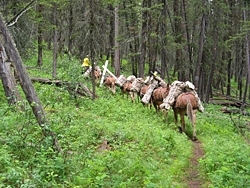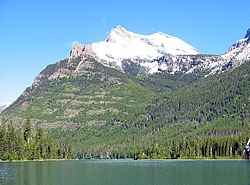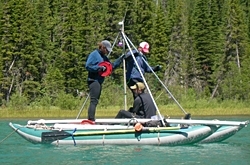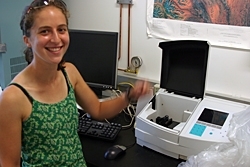Middlebury junior's research looks at climate change and recession of glaciers [AUDIO SLIDESHOW]
By Thomas Brant ‘10
MIDDLEBURY, Vt. - On the wall of a geology laboratory in McCardell Bicentennial Hall, a half-scale x-ray image of three 14-foot long sediment cores hangs like the giant columns of the Parthenon. Standing beside the images, Middlebury junior Lilly Corenthal explains the importance of the contrasting layers that appear in the x-rays of the cores, which represent a period of about 8,000 years.
“If the grains are really big, that could be a period of high glacial activity, and if the grains are much finer, it shows that deposition - the rate at which the layers build up - was occurring more slowly,” Corenthal said.
| [video:hhttps://www.youtube.com/watch?v=wC-Jk9F6-Bowidth:275] |




The different-sized sediment grains are just one component of a research project that could help shed new light on the alarming rate at which glaciers are receding in Montana’s Glacier National Park - a phenomenon most scientists attribute to global warming. When the first surveys were made in 1850, the park contained 150 individual glaciers. Today, just 27 remain.
Corenthal, of Larchmont, N.Y., is working with Associate Professor of Geology Jeff Munroe to create a detailed chronology of glacial activity in Glacier National Park during the Holocene epoch, which began around 10,000 years ago. She hopes that her analysis of the cores, taken from the bed of Upper Kintla Lake, will provide a perspective in which to evaluate the rapid retreat of the Agassiz Glacier, which is located just upstream.
To provide that perspective, Corenthal is studying the sediment grain size distribution and the amount of biogenic silica -the remains of aquatic algae - found in each layer shown in the x-ray image. More silica in a certain layer could mean that the lake water was warmer at that time because the Agassiz Glacier was absent or reduced in size, while less silica might be a sign of colder water due to increased glacier area.
Other analyses of the cores completed in the past year will also help elucidate past glacier behavior.
“Everything that has ever accumulated in a lake stays there as either organic matter or rock material,” said Corenthal, “so the first analysis we did was for magnetic susceptibility, which is a measure of the different rock types that are washing into the lake. Then we did a test called loss-on-ignition, which gives us an overview of how much organic matter has been in the lake.”
Corenthal and Munroe will combine the grain size and biogenic silica data with results from the other tests run on the cores to generate an integrated climate history for the Agassiz Glacier and Upper Kintla Lake.
The project started in June 2007, when Munroe, a colleague from the State University of New York at Geneseo, and Logan Duran, a 2008 Middlebury graduate, worked with National Park Service and US Geological Survey personnel to transport the coring equipment to the lake in the remote northwest corner of the park. Over the course of five days, the crew retrieved three long cores, including the one that Corenthal is studying, which was taken from more than 100 feet beneath the lake surface. The cores were divided into shorter sections for transport back to the trailhead on horseback and shipping back to Middlebury. In September 2007, employees at Porter Hospital near the college volunteered their time to x-ray the cores, providing a glimpse of the complicated layering they contain.
According to Munroe, this research is providing important context for current discussions of global climate change and its effects because so little is known about the history of the glaciers in Glacier National Park.
“We really have no idea how long the modern glaciers in Glacier National Park have existed,” Munroe explained.
But what scientists do know is that the 27 remaining glaciers are all retreating rapidly and may disappear entirely within the next few decades.
“Glaciers are obvious manifestations of local climate,” Munroe said. “Given the intuitive nature of the connection between warmer temperatures and melting ice, it is easy to understand why so many people view Glacier National Park as a canary in the coal mine for global climate change. If it is demonstrated that glaciers in the park have existed for thousands of years, then the distinct possibility that they will disappear entirely in the next few decades will be a powerful motivation for addressing global climate change.”
Through her research on the samples, Corenthal hopes to get a better understanding of climate change from a scientific perspective.
“Climate change has been an issue that I’ve been interested in for the past couple of years,” Corenthal said. “Not just the science of it but how it relates to our economy and our lives and everything that’s going on in the world right now.”
“I’m excited to have the opportunity this summer to really get into the science of it and to know what’s going on in the world we live in from a climatic perspective.”
—end—


